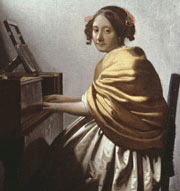A painting of Dutch master Johannes Vermeer's "Young Woman Seated At The Virginals,"
that for decades was suspected of being a fake
was sold for $30 million (£16.2 million) at
Sotheby's in London on July 7, 2004. Until March 30, 2005, the
Vermeer's small wander was on display at the Philadelphia Museum of
Art. The opportunity to see a Vermeer at the Philadelphia Museum of Art has been
very rare since
the Widener Collection went to the National Gallery in Washington in 1942.
The most recent exhibition of four Vermeers together with other genre masterpieces of
Dutch Golden Age (1585-1718) was in 1984.
From May 1, 2005 the Vermeer's masterpiece
together with Wynn's recent high-profile purchases, such as John
Singer Sergeant's portrait
of Robert Louis Stevensonin and other works from his art collection will be exhibited in the specially build for this occasion art gallery pavilion in Las Vegas.
The art gallery pavilion is located in a new $2.7 billion high-style resort complete
with golf course, lakes, fountains,
a fake mountain and restaurants.
 Amid great publicity, the painting was bought by a Las Vegas Casino owner Steve Wynn for more than five
times its pre-sale estimate. Not only was it the first Vermeer to appear at auction since 1921,
but also it was the only one remaining in private hands aside from one in the Royal Collection
(known as "The Music Lesson," (1662-1665)).
Since 1960 the painting had been in the possession of the Belgian dealer Baron Frederic Rolin,
who made great efforts to authenticate it after revelations that a Dutch forger had sold a number
of fake Vermeers in the 1930s and 1940s.
The painting was confirmed to be Vermeer after 10 years of meticulous study and testing by a group of scholars,
museum curators, painting conservators, costume experts, paint analysts and auction house experts. In National Gallery of London it was
compared with two larger Vermeers: "A lady standing at the virginal" and "A lady seated at the virginal", where after careful studies
conservators concluded that they were all done by the same hand. A consultant of the University College who analyzed the pigments in
the painting concluded that they correspond to the unusual, expensive and rare pigments used by the artist.
In addition to the paint also the canvas used by painter was carefully examined and compared with the canvas used by
Vermeer to paint "The Lacemaker" now in Louvre.
"The two are so similar that they could have been cut from the same bolt of cloth",
expert reported.
Amid great publicity, the painting was bought by a Las Vegas Casino owner Steve Wynn for more than five
times its pre-sale estimate. Not only was it the first Vermeer to appear at auction since 1921,
but also it was the only one remaining in private hands aside from one in the Royal Collection
(known as "The Music Lesson," (1662-1665)).
Since 1960 the painting had been in the possession of the Belgian dealer Baron Frederic Rolin,
who made great efforts to authenticate it after revelations that a Dutch forger had sold a number
of fake Vermeers in the 1930s and 1940s.
The painting was confirmed to be Vermeer after 10 years of meticulous study and testing by a group of scholars,
museum curators, painting conservators, costume experts, paint analysts and auction house experts. In National Gallery of London it was
compared with two larger Vermeers: "A lady standing at the virginal" and "A lady seated at the virginal", where after careful studies
conservators concluded that they were all done by the same hand. A consultant of the University College who analyzed the pigments in
the painting concluded that they correspond to the unusual, expensive and rare pigments used by the artist.
In addition to the paint also the canvas used by painter was carefully examined and compared with the canvas used by
Vermeer to paint "The Lacemaker" now in Louvre.
"The two are so similar that they could have been cut from the same bolt of cloth",
expert reported.
The canvas is very small 26 cm x 21 cm. It shows with typical for Vermeer simplicity an intimate scene of young woman in a yellow woolen shawl over a white satin dress or skirt, with pearls around her neck and an arrangement of white and red ribbons in her hair seated at the virginal with her head turned in direction of the viewer. She seems waiting for the invitation to play from a person who just entered the room. Her right index finger ready to depress a key, suggesting that the visitor is an accompanying musician, maybe even music teacher. Her splendidly rendered satin dress, the raking light that alone describes the background wall, and the frozen calm of this momentary scene are hallmark traits of Vermeer's masterpieces. However, technical evidence suggests that the yellow cloak was partially repainted and expanded by another painter, perhaps after the artist's death in 1675. The identity of the sitter has been the subject of speculation, with some indications that it shows Johannes Vermeer's younger daughter Elizabeth.
Music played an important function in upper-middle class Dutch households, for it facilitated social contact between the sexes. The musical instrument the young woman is sitting at had a traditional association with the purity of love and, moreover, music itself alludes metaphorically to the harmony of two souls in love
Painted in 1670 the painting for first time appeared in late 17-century sale-catalog where painter's friend and most important patron in one person, Peter van Ruijven, was mentioned as an owner. By early 19 century the painting was in Wessel Ryers collection. By 1904 it was owned by Sir Alfred Beit, an Irish collector who also owned famous another Vermeer painting "Lady writing a letter with her maid". In 1960 Sir Alfred sold it to Barron Freddy Rolin. Though Baron Rolin did not live to see the painting sold, its authenticity was finally established to the satisfaction of most before the Sotheby's sale.